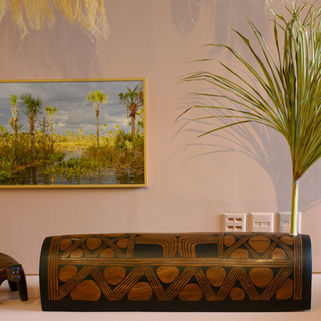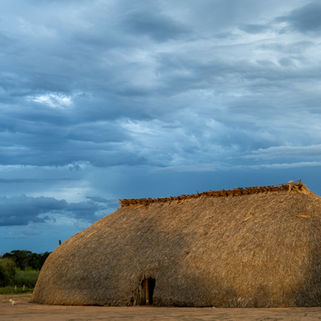
Xingu Project Case: Indigenous Reflections in Contemporary Design
Xingu
Project
The Xingu Project is much more than just sharing knowledge from the forest or the results of in-depth dyeing research. It's about the power that arises from the respectful encounter between traditional and academic knowledge, different cultures, and multiple ways of seeing and relating to the world.
Conceived by Maria Fernanda Paes de Barros, the project emerged in 2020 from a relationship built over years with the Mehinaku people of the Xingu Indigenous Territory (MT). The result of coexistence, deep listening, and mutual trust, its purpose is to give visibility to indigenous ancestry, creating bridges between artisanal traditions and contemporary design.
The project brought knowledge about natural dyeing, present in other traditional cultures, to the Kaupüna village as a new creative and economic path for the community. More than teaching, the goal was to co-create: to jointly build a unique palette of colors extracted from the forest, respecting time, knowledge, and local biodiversity.

Results
Achieved
• Creation of a palette with 12 natural colors, named in the Mehinaku language, imbued with emotional, symbolic, and spiritual meanings;
• Use of local raw materials (tree bark, leaves, and seeds), with sustainable management and respect for the biome;
• Active participation of 17 women and 8 men in all stages—from harvesting to dyeing—strengthening creative autonomy;
• Involvement of 12 children, who recorded the process through drawings and conversations, ensuring the oral and visual transmission of knowledge;
• Production of artistic pieces that have been presented in exhibitions in Brazil and abroad, bringing Mehinaku history and culture to new audiences;
• A digital catalog and a mini-documentary; Building a material and symbolic legacy that inspires, values, and connects traditions and contemporary times.
Impact

The Xingu Project goes beyond aesthetics. It represents:
• Technical and creative training based on natural dyeing;
• Expansion of female artisanal production that does not affect diversity and its reach;
• Strengthening local identity, especially among young people, who have come to see traditions as a path to the future.
Works created through the project have been exhibited in Brazil, Mexico, France, Switzerland, Hungary, and Israel, carrying with them the soul of the Xingu and fostering dialogue between different worlds. The Xingu Project is proof that collaboration between companies, designers, and traditional communities can generate real value, building bridges and legacies that transcend material resources.

Agradecimentos
Manifestamos nossa profunda gratidão a toda equipe pela dedicação, empenho e cuidado com cada detalhe deste projeto: Carol Magliari, Daniel Freire, Daniela Karam Vieira, Kulikyrda Mehinako, Lucas Rosin, Maibe Maroccolo, Maria Helena Emediato, Rita Basile, Rosemi Amorim e Victor Affaro — vocês foram essenciais.
Agradecemos muitíssimo ao Museu A Casa e toda a sua equipe, por acolher a exposição e chancelar institucionalmente o projeto; à The Dealers, pelo registro dos momentos preciosos; à Garland Magazine, pelo espaço e divulgação global; à Sherwin-Williams do Brasil, por acreditar no potencial deste trabalho; e, especialmente, ao povo Mehinaku da aldeia Kaupüna, cuja confiança e entrega tornaram este sonho possível e inspirador.
Estendemos nossa gratidão aos amigos que, de formas diversas, contribuíram nos meses que antecederam este momento: Junior Guimarães, por nos conectar a potenciais patrocinadores, possibilitando o encontro com Patrícia Fecci, Beatriz Luz e Stefany Braga da Sherwin-Williams do Brasil, que ajudaram a tornar realidade este projeto; Neeltje Thomas, pela sensibilidade que deu vida a algumas obras no estúdio da Yankatu; Sheila Maioralli, por dedicar tempo e atenção às nossas dúvidas com carinho e delicadeza; Olívia Bonan, pelo aconselhamento cuidadoso em todas as fases do projeto; Fábio Mota, pelo olhar que ajudou a compor nosso mini documentário; e Maria Helena Emediato, que traduziu a alma do projeto em seu logo, vibrou a cada conquista, nos ouviu nos momentos difíceis e realizou um trabalho impecável.
Agradecemos também à equipe da FUNAI, que colaborou na análise dos documentos para que pudéssemos adentrar o Território Indígena do Xingu com respeito e integridade.
Registramos nestas páginas nossa imensa gratidão.
Maria Fernanda Paes de Barros e Angelo Miguel Lima
Ficha Técnica
Idealização e coordenação: Maria Fernanda Paes de Barros @mariafernandapaesdebarros
Produção Executiva: Angelo Miguel Lima @angelomigue
Produção Local: Kulikyrda Mehinako @stivemehinako
Pesquisa Tintorial: Maibe Maroccolo | Mattricaria @mattricaria
Identidade Visual e Design Gráfico: Maria Helena Emediato @lenaemediato
Fotos: Lucas Rosin @lucasrosin
Assistente de Fotografia: Carolina Magliari @_carolmagliari
Expografia: Daniela Karam Vieira @danielakaram
Filmmaker: Victor Affaro @victoraffaro
Edição de Vídeo: Fábio Mota @fabiomotaeditor e Rita Basile @basileproducoes
Legendas, Libras e Audiodescrição (Vídeo): Temporal Produtora de Acessibilidade e Comunicação
Textos: Angelo Miguel Lima
Revisão: Fernanda Prates de Mendonça
Tradução: Maria Fernanda Paes de Barros
Curadoria: Kulikyrda Mehinako e Maria Fernanda Paes de Barros
Assessoria de Comunicação e imprensa: Bacuri Comunicação @bacuri.ag
Contabilidade: JRC Assessoria Contábil
Gestão de Incentivo, Controladoria e Prestação de Contas: Versa Cultural @versacultural
Consultoria jurídica: BSA Advogados @bsa.advs
Fotos da Exposição: Felipe Perazzolo @zzfotoevideo
Artistas:
Iepelo Mehinako
Itxuna Mehinako
Kamaiulalu Mehinako
Kauta Mehinako
Kawakanamu Mehinako
Kawiru Mehinako
Kayanaku Aweti
Kulikyrda Mehinako
Kuyawalu Aweti
Maithiakalu Mehinako
Makuai Mehinako
Makaulaka Mehinako
Maria Fernanda Paes de Barros
Mayawari Mehinako
Paipualu Mehinako
Pakuiura Mehinako
Takulalu Mehinako
Tsukuyut Raisa Mehinako
Ufeku Samira
Uruhu Mehinako
Waxamani Mehinako
Wayuni Lili Mehinako
Yahati Mehinaku
Yamanipalu Alice Mehinako
Yaritsu Waura
Yaruru Mehinako
Yatapi Mehinako
Yawaki Mehinako
Lei Federal de Incentivo à Cultura / Lei Rouanet
Apoio: Garland Magazine @garlandmagazine e The Dealers @_thedealers
Parceria: Museu A CASA @museuacasa
Patrocínio: Sherwin Williams do Brasil @sherwinwilliamsbr
Realização: Yankatu@_yankatu, Ministério da Cultura @minc e Governo Federal @govbr


























